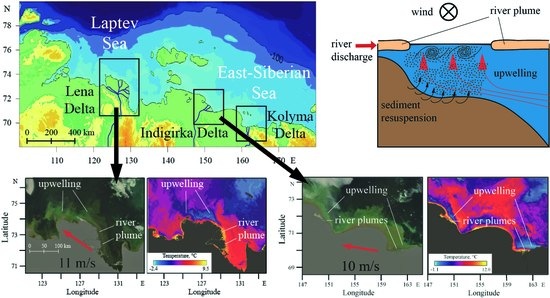Wind-Driven Coastal Upwelling near Large River Deltas in the Laptev and East-Siberian Seas
Abstract
1. Introduction
2. Study Area, Data, and Methods
2.1. Study Area
2.2. Data and Methods
3. Results
3.1. Coastal Upwelling near the Lena Delta in the Laptev Sea
3.2. Coastal Upwelling near the Indigirka and Kolyma Deltas in the East-Siberian Sea
4. Discussion
5. Conclusions
Author Contributions
Funding
Acknowledgments
Conflicts of Interest
References
- Carmack, E.C. The freshwater budget of the Arctic Ocean: Sources, storage and sinks. In The Freshwater Budget of the Arctic Ocean; Lewis, E.L., Jones, E.P., Eds.; Kluwer: Dordrecht, The Netherlands, 2000; pp. 91–126. [Google Scholar]
- Dai, A.; Trenberth, K.E. Estimates of freshwater discharge from continents: Latitudinal and seasonal variations. J. Hydrometeorol. 2002, 3, 660–687. [Google Scholar] [CrossRef]
- Aagaard, K.; Carmack, E.C. The Arctic Ocean and climate: A perspective. In The Polar Oceans and Their Role in Shaping the Global Environment; Johannessen, O.M., Muench, R.D., Overland, J.E., Eds.; AGU: Washington, DC, USA, 1994; Volume 85, pp. 5–20. [Google Scholar] [CrossRef]
- Carmack, E.C. The alpha/beta ocean distinction: A perspective on freshwater fluxes, convection, nutrients and productivity in high-latitude seas. Deep Sea Res. Part Ii 2007, 54, 2578–2598. [Google Scholar] [CrossRef]
- Carmack, E.C.; Winsor, P.; Williams, W. The contiguous panarctic Riverine Coastal DomaIn A unifying concept. Prog. Oceanogr. 2015, 139, 13–23. [Google Scholar] [CrossRef]
- Yamamoto-Kawai, M.; McLaughlin, F.A.; Carmack, E.C.; Nishino, S.; Shimada, K.; Kurita, N. Surface freshening of the Canada Basin, 2003–2007: River runoff versus sea ice meltwater. J. Geophys. Res. 2009, 114, C00A05. [Google Scholar] [CrossRef]
- Tremblay, J.E.; Gagnon, J. The effects of irradiance and nutrient supply on the productivity of Arctic waters: A perspective on climate change. In Influence of Climate Change on the Changing Arctic and Subarctic Conditions; Nihoul, C.J., Kostianoy, A.G., Eds.; Springer Science: Berlin, Germany, 2009; pp. 73–92. [Google Scholar] [CrossRef]
- Li, W.K.W.; McLaughlin, F.A.; Lovejoy, C.; Carmack, E.C. Smallest algae thrive as the Arctic Ocean freshens. Science 2009, 326, 539. [Google Scholar] [CrossRef] [PubMed]
- McLaughlin, F.A.; Carmack, E.C. Nutricline deepening in the Canada Basin, 2003–2009. Geophys. Res. Lett. 2010, 37, L24602. [Google Scholar] [CrossRef]
- Zavialov, P.O.; Izhitskiy, A.S.; Osadchiev, A.A.; Pelevin, V.V.; Grabovskiy, A.B. The structure of thermohaline and bio-optical fields in the upper layer of the Kara Sea in September 2011. Oceanology 2015, 55, 461–471. [Google Scholar] [CrossRef]
- Nummelin, A.; Ilicak, M.; Li, C.; Smedsrud, L.H. Consequences of future increased Arctic runoff on Arctic Ocean stratification, circulation, and sea ice cover. J. Geophys. Res. Oceans 2016, 121, 617–637. [Google Scholar] [CrossRef]
- Carmack, E.C.M.; Yamamoto-Kawai, T.W.; Haine, S.; Bacon, B.A.; Bluhm, C.; Lique, H.; Melling, I.V.; Polyakov, F.; Straneo, M.L.; Williams, W.J. Freshwater and its role in the Arctic Marine System: Sources, disposition, storage, export, and physical and biogeochemical consequences in the Arctic and global oceans. J. Geophys. Res. Biogeosci. 2016, 121, 675–717. [Google Scholar] [CrossRef]
- Osadchiev, A.A.; Izhitskiy, A.S.; Zavialov, P.O.; Kremenetskiy, V.V.; Polukhin, A.A.; Pelevin, V.V.; Toktamysova, Z.M. Structure of the buoyant plume formed by Ob and Yenisei river discharge in the southern part of the Kara Sea during summer and autumn. J. Geophys. Res. Oceans 2017, 122, 5916–5935. [Google Scholar] [CrossRef]
- Osadchiev, A.A.; Asadulin, E.E.; Miroshnikov, A.Y.; Zavialov, I.B.; Dubinina, E.O.; Belyakova, P.A. Bottom sediments reveal inter-annual variability of interaction between the Ob and Yenisei plumes in the Kara Sea. Sci. Rep. 2019, 9, 18642. [Google Scholar] [CrossRef] [PubMed]
- Gordeev, V.V.; Martin, J.M.; Sidorov, J.S.; Sidorova, M.V. A reassessment of the Eurasian river input of water, sediment, major elements, and nutrients to the Arctic Ocean. Am. J. Sci. 1996, 296, 664–691. [Google Scholar] [CrossRef]
- Holmes, R.M.; McClelland, J.W.; Peterson, B.J.; Shiklomanov, I.A.; Shiklomanov, A.I.; Zhulidov, A.V.; Gorgeev, V.V.; Bobrovitskaya, N.N. A circumpolar perspective on fluvial sediment flux to the Arctic Ocean. Glob. Biogeochem. Cycles 2002, 16, 1098. [Google Scholar] [CrossRef]
- Pavlov, V.K.; Timokhov, L.A.; Baskakov, G.A.; Kulakov, M.Y.; Kurazhov, V.K.; Pavlov, P.V.; Pivovarov, S.V.; Stanovoy, V.V. Hydrometeorological Regime of the Kara, Laptev, and East-Siberian Seas; University of Washington: Washington, DC, USA, 1996. [Google Scholar]
- Aagaard, K.; Carmack, E.C. The role of sea ice and other fresh water in the Arctic circulation. J. Geophys. Res. 1989, 94, 14485–14498. [Google Scholar] [CrossRef]
- Williams, W.J.; Carmack, E.C. The ‘interior’ shelves of the Arctic Ocean: Physical oceanographic setting, climatology and effects of sea-ice retreat on cross-shelf exchange. Prog. Oceanogr. 2015, 139, 24–31. [Google Scholar] [CrossRef]
- Haine, T.W.N.; Curry, B.; Gerdes, R.; Hansen, E.; Karcher, M.; Lee, C.; Rudels, B.; Spreen, G.; Steur, L.; Stewart, K.D.; et al. Arctic freshwater export: Status, mechanisms, and prospects. Glob. Planet. Chang. 2015, 125, 13–35. [Google Scholar] [CrossRef]
- Munchow, A.; Weingartner, T.J.; Cooper, L.W. The summer hydrography and surface circulation of the East Siberian Shelf Sea. J. Phys. Oceanogr. 1999, 19, 2167–2182. [Google Scholar] [CrossRef][Green Version]
- Semiletov, I.; Dudarev, O.; Luchin, V.; Charkin, A.; Shin, K.H.; Tanaka, N. The East Siberian Sea as a transition zone between Pacific-derived waters and Arctic shelf waters. Geophys. Res. Lett. 2005, 32, L10614. [Google Scholar] [CrossRef]
- Dmitrenko, I.; Kirillov, S.; Eicken, H.; Markova, N. Wind-driven summer surface hydrography of the eastern Siberian shelf. Geophys. Res. Lett. 2005, 32, L14613. [Google Scholar] [CrossRef]
- Dudarev, O.V.; Semiletov, I.P.; Charkin, A.N.; Botsul, A.I. Deposition settings on the continental shelf of the East Siberian Sea. Dokl. Earth Sci. 2005, 409, 1000–1005. [Google Scholar] [CrossRef]
- Saveleva, N.I.; Semiletov, I.P.; Pipko, I.I. Impact of synoptic processes and river discharge on the thermohaline structure in the East-Siberian Sea shelf. Russ. Meteorol. Hydrol. 2008, 33, 240–246. [Google Scholar] [CrossRef]
- Dmitrenko, I.A.; Kirillov, S.A.; Krumpen, T.; Makhotin, M.; Abrahamsen, E.P.; Willmes, S.; Bloshkina, E.; Holemann, J.A.; Kassens, H.; Wegner, C. Wind-driven diversion of summer river runoff preconditions the Laptev Sea coastal polynya hydrography: Evidence from summer-to-winter hydrographic records of 2007–2009. Cont. Shelf Res. 2010, 30, 1656–1664. [Google Scholar] [CrossRef]
- Saveleva, N.I.; Salyuk, A.N.; Propp, L.N. Peculiar features of the thermohaline and hydrochemical water structure in the southeastern Laptev Sea. Oceanology 2010, 50, 869–876. [Google Scholar] [CrossRef]
- Hölemann, J.A.; Kirillov, S.; Klagge, T.; Novikhin, A.; Kassens, H.; Timokhov, L. Near-bottom water warming in the Laptev Sea in response to atmospheric and sea-ice conditions in 2007. Polar Res. 2011, 30, 6425. [Google Scholar] [CrossRef]
- Shakhova, N.; Semiletov, I.; Leifer, I.; Sergienko, V.; Salyuk, A.; Kosmach, D.; Chernykh, D.; Stubbs, C.; Nicolsky, D.; Tumskoy, V.; et al. Ebullition and storm-induced methane release from the East Siberian Arctic Shelf. Nat. Geosci. 2014, 7, 64. [Google Scholar] [CrossRef]
- Dudarev, O.V.; Charkin, A.N.; Semiletov, I.P.; Pipko, I.I.; Pugach, S.P.; Chernykh, D.V.; Shakhova, N.E.; Sergienko, V.I. Peculiarities of the present-day morpholithogenesis on the Laptev Sea Shelf: Semenovskaya shoal (Vasema Land). Dokl. Earth Sci. 2015, 462, 510–516. [Google Scholar] [CrossRef]
- Semiletov, I.; Pipko, I.; Gustafsson, O.; Anderson, L.G.; Sergienko, V.; Pugach, S.; Dudarev, O.V.; Charkin, A.N.; Gukov, A.; Broder, L.; et al. Acidification of East Siberian Arctic Shelf waters through addition of freshwater and terrestrial carbon. Nat. Geosci. 2016, 9, 361. [Google Scholar] [CrossRef]
- Sukhanova, I.N.; Filint, M.V.; Georgieva, E.J.; Lange, E.K.; Kravchishina, M.D.; Demidov, A.B.; Nedospasov, A.A.; Polukhin, A.A. The structure of phytoplankton communities in the eastern part of the Laptev Sea. Oceanology 2017, 57, 75–90. [Google Scholar] [CrossRef]
- Braga, F.; Zaggia, L.; Bellafiore, D.; Bresciani, M.; Giardino, C.; Lorenzetti, G.; Maicu, F.; Manzo, C.; Riminucci, F.; Ravaioli, M.; et al. Mapping turbidity patterns in the Po river prodelta using multi-temporal Landsat 8 imagery. Estuar. Coast. Shelf Sci. 2017, 198, 555–567. [Google Scholar] [CrossRef]
- Semiletov, I.P.; Pipko, I.I.; Shakhova, N.E.; Dudarev, O.V.; Pugach, S.P.; Charkin, A.N.; Mcroy, C.P.; Kosmach, D.; Gustafsson, O. Carbon transport by the Lena River from its headwaters to the Arctic Ocean, with emphasis on fluvial input of terrestrial particulate organic carbon vs. carbon transport by coastal erosion. Biogeoscience 2011, 8, 2407–2426. [Google Scholar] [CrossRef]
- Kosyan, R. The Diversity of Russian Estuaries and Lagoons Exposed to Human Influence; Springer: Basel, Switzerland, 2016. [Google Scholar] [CrossRef]
- Sorokin, Y.I.; Sorokin, P.Y. Plankton and primary production in the Lena River estuary and in the south-eastern Laptev Sea. Estuar. Coast. Shelf Sci. 1996, 43, 399–418. [Google Scholar] [CrossRef]
- Nikanorov, A.M.; Bryzgalo, V.A.; Kosmenko, S.; Reshetnyak, S. The Kolyma River mouth area under present conditions of anthropogenic impact. Russ. Meteorol. Hydrol. 2011, 36, 549–558. [Google Scholar] [CrossRef]
- Kraberg, A.C.; Druzhkova, E.; Heim, B.; Loeder, M.J.G.; Wiltshire, K.H. Phytoplankton community structure in the Lena Delta (Siberia, Russia) in relation to hydrography. Biogeoscience 2013, 10, 7263–7277. [Google Scholar] [CrossRef]
- Geyer, W.R.; Hill, P.S.; Kineke, G.C. The transport, transformation and dispersal of sediment by buoyant coastal flows. Cont. Shelf Res. 2004, 24, 927–949. [Google Scholar] [CrossRef]
- Korotkina, O.A.; Zavialov, P.O.; Osadchiev, A.A. Submesoscale variability of the current and wind fields in the coastal region of Sochi. Oceanology 2011, 51, 745–754. [Google Scholar] [CrossRef]
- Korotkina, O.A.; Zavialov, P.O.; Osadchiev, A.A. Synoptic variability of currents in the coastal waters of Soch. Oceanology 2014, 54, 545–556. [Google Scholar] [CrossRef]
- Korotenko, K.A.; Osadchiev, A.A.; Zavialov, P.O.; Kao, R.C.; Ding, C.F. Effects of bottom topography on dynamics of river discharges in tidal regions: Case study of twin plumes in Taiwan Strait. Ocean Sci. 2014, 10, 865–879. [Google Scholar] [CrossRef]
- Horner-Devine, A.R.; Hetland, R.D.; MacDonald, D.G. Mixing and transport in coastal river plumes. Annu. Rev. Fluid Mech. 2015, 47, 569–594. [Google Scholar] [CrossRef]
- Lee, J.; Liu, J.T.; Hung, C.C.; Lin, S.; Du, X. River plume induced variability of suspended particle characteristics. Mar. Geol. 2016, 380, 219–230. [Google Scholar] [CrossRef]
- Osadchiev, A.A.; Korotenko, K.A.; Zavialov, P.O.; Chiang, W.S.; Liu, C.C. Transport and bottom accumulation of fine river sediments under typhoon conditions and associated submarine landslides: Case study of the Peinan River, Taiwan. Nat. Hazards Earth Syst. Sci. 2016, 16, 41–54. [Google Scholar] [CrossRef]
- Osadchiev, A.A.; Korshenko, E.A. Small river plumes off the north-eastern coast of the Black Sea under average climatic and flooding discharge conditions. Ocean Sci. 2017, 13, 465–482. [Google Scholar] [CrossRef]
- Osadchiev, A.A.; Sedakov, R.O. Spreading dynamics of small river plumes off the northeastern coast of the Black Sea observed by Landsat 8 and Sentinel-2. Rem. Sens. Environ. 2019, 221, 522–533. [Google Scholar] [CrossRef]
- Semiletov, I.P.; Shakhova, N.E.; Sergienko, V.I.; Pipko, I.I.; Dudarev, O.V. On carbon transport and fate in the East Siberian Arctic land–shelf–atmosphere system. Environ. Res. Lett. 2012, 7, 15201. [Google Scholar] [CrossRef]
- Clarke, T.L.; Lesht, B.; Young, R.A.; Swift, D.J.P.; Freeland, G.L. Sediment resuspension by surface-wave action: An examination of possible mechanisms. Mar. Geol. 1982, 49, 43–59. [Google Scholar] [CrossRef]
- De Jorge, V.N.; Van Beusekom, J.E.E. Wind-and tide-induced resuspension of sediment and microphytobenthos from tidal flats in the Ems estuary. Limnol. Oceanogr. 1995, 40, 776–778. [Google Scholar] [CrossRef]
- Joordens, J.C.A.; Souza, A.J.; Visser, A. The influence of tidal straining and wind on suspended matter and phytoplankton distribution in the Rhine outflow region. Cont. Shelf Res. 2001, 21, 301–325. [Google Scholar] [CrossRef]
- Kularatne, S.; Pattiaratchi, C. Turbulent kinetic energy and sediment resuspension due to wave groups. Cont. Shelf Res. 2008, 28, 726–736. [Google Scholar] [CrossRef]
- Carlin, J.A.; Lee, G.H.; Dellapenna, T.M.; Laverty, P. Sediment resuspension by wind, waves, and currents during meteorological frontal passages in a micro-tidal lagoon. Estuar. Coast. Shelf Sci. 2016, 172, 24–33. [Google Scholar] [CrossRef]
- Allen, J.S.; Newberger, P.A.; Federiuk, J. Upwelling circulation on the Oregon continental shelf. Part I: Response to idealized forcing. J. Phys. Oceanogr. 1995, 25, 1843–1866. [Google Scholar] [CrossRef]
- Austin, J.A.; Lentz, S.J. The inner shelf response to wind-driven upwelling and downwelling. J. Phys. Oceanogr. 2002, 32, 2171–2193. [Google Scholar] [CrossRef]
- Gan, J.; Lu, Z.; Dai, M.; Cheung, A.Y.; Liu, H.; Harrison, P. Biological response to intensified upwelling and to a river plume in the northeastern South China Sea: A modeling study. J. Geophys. Res. Oceans 2010, 115, C09001. [Google Scholar] [CrossRef]
- Lentz, S.J.; Fewings, M.R. The wind- and wave-driven inner-shelf circulation. Annu. Rev. Mar. Sci. 2012, 4, 317–343. [Google Scholar] [CrossRef] [PubMed]
- Fong, D.A.; Geyer, W.R. Response of a river plume during an upwelling favorable wind event. J. Geophys. Res. Oceans 2001, 106, 1067–1084. [Google Scholar] [CrossRef]
- García Berdeal, I.; Hickey, B.M.; Kawase, M. Influence of wind stress and ambient flow on a high discharge river plume. J. Geophys. Res. Oceans 2002, 107, 3130. [Google Scholar] [CrossRef]
- Lentz, S.J. The response of buoyant coastal plumes to upwelling-favorable winds. J. Phys. Oceanogr. 2004, 34, 2458–2469. [Google Scholar] [CrossRef]
- Osadchiev, A.A.; Zavialov, P.O. Lagrangian model for surface-advected river plume. Cont. Shelf Res. 2013, 58, 96–106. [Google Scholar] [CrossRef]
- Pimenta, F.M.; Kirwan, A.D., Jr. The response of large outflows to wind forcing. Cont. Shelf Res. 2014, 89, 24–37. [Google Scholar] [CrossRef]
- Houghton, R.W.; Tilburg, C.E.; Garvine, R.W.; Fong, D.A. Delaware River plume response to a strong upwelling-favorable wind event. Geophys. Res. Lett. 2004, 31, L07302. [Google Scholar] [CrossRef]
- Curtis Roegner, G.; Hickey, B.M.; Newton, J.A.; Shanks, A.L.; Armstrong, D.A. Wind-induced plume and bloom intrusions into Willapa Bay, Washington. Limnol. Oceanogr. 2002, 47, 1033–1042. [Google Scholar] [CrossRef]
- Hill, J.K.; Wheeler, P.A. Organic carbon and nitrogen in the northern California current system: Comparison of offshore, river plume, and coastally upwelled waters. Prog. Oceanogr. 2002, 53, 369–387. [Google Scholar] [CrossRef]
- Voss, M.D.; Bombar, N.; Loick, J.W. Dippner Riverine influence on nitrogen fixation in the upwelling region off Vietnam, South China Sea. Geophys. Res. Lett. 2006, 33, L07604. [Google Scholar] [CrossRef]
- Han, A.; Dai, M.; Kao, S.J.; Gan, J.; Li, Q.; Wang, L.; Zhai, W.; Wang, L. Nutrient dynamics and biological consumption in a large continental shelf system under the influence of both a river plume and coastal upwelling. Limnol. Oceanogr. 2012, 57, 486–502. [Google Scholar] [CrossRef]
- Tseng, Y.F.; Lin, J.; Dai, M.; Kao, S.J. Joint effect of freshwater plume and coastal upwelling on phytoplankton growth off the Changjiang River. Biogeoscience 2014, 11, 409–423. [Google Scholar] [CrossRef]
- Pickart, R.S.; Moore, G.W.K.; Torres, D.J.; Fratantoni, P.S.; Goldsmith, R.A.; Yang, J. Upwelling on the continental slope of the Alaskan Beaufort Sea: Storms, ice, and oceanographic response. J. Geophys. Res. 2009, 114, C00A13. [Google Scholar] [CrossRef]
- Tremblay, J.E.; Belanger, S.; Barber, D.G.; Asplin, M.; Martin, J.; Darnis, G.; Fortier, L.; Gratton, Y.; Link, H.; Archambault, P.; et al. Climate forcing multiplies biological productivity in the coastal Arctic Ocean. Geophys. Res. Lett. 2011, 38, L18604. [Google Scholar] [CrossRef]
- Falk-Petersen, S.; Pavlov, V.; Berge, J.; Cottier, F.; Kovacs, K.M.; Lydersen, C. At the rainbow’s end: High productivity fueled by winter upwelling along an Arctic shelf. Polar Biol. 2015, 38, 5–11. [Google Scholar] [CrossRef]
- Sevigny, C.; Gratton, Y.; Galbraith, P.S. Frontal structures associated with coastal upwelling and ice-edge subduction events in southern Beaufort Sea during the Canadian Arctic Shelf Exchange Study. J. Geophys. Res. Oceans 2015, 120, 2523–2539. [Google Scholar] [CrossRef]
- Dmitrenko, I.A.; Kirillov, S.A.; Rudels, B.; Babb, D.G.; Myers, P.G.; Stedmon, C.A.; Bendtsen, J.; Ehn, J.K.; Pedersen, L.T.; Rysgaard, S.; et al. Variability of the Pacific-Derived Arctic Water Over the Southeastern Wandel Sea Shelf (Northeast Greenland) in 2015–2016. J. Geophys. Res. Oceans 2019, 124, 349–373. [Google Scholar] [CrossRef]
- Pisareva, M.N.; Pickart, R.S.; Lin, P.; Fratantoni, P.S.; Weingartner, T.J. On the nature of wind-forced upwelling in Barrow Canyon. Deep Sea Res. Part Ii 2019, 162, 63–78. [Google Scholar] [CrossRef]
- Williams, W.J.; Carmack, E.C. Combined effect of wind-forcing and isobath divergence on upwelling at Cape Bathurst, Beaufort Sea. J. Mar. Res. 2008, 66, 645–663. [Google Scholar] [CrossRef]
- Macdonald, R.W.; Yu, Y. The Mackenzie Estuary of the Arctic Ocean. In Estuaries. The Handbook of Environmental Chemistry; Wangersky, P.J., Ed.; Springer: Berlin, Germany, 2006; Volume 5H. [Google Scholar] [CrossRef]
- Mulligan, R.P.; Perrie, W.; Solomon, S. Dynamics of the Mackenzie River plume on the inner Beaufort shelf during an open water period in summer. Estuar. Coast. Shelf Sci. 2010, 89, 214–220. [Google Scholar] [CrossRef]
- Mulligan, R.P.; Perrie, W. Circulation and structure of the Mackenzie River plume in the coastal Arctic Ocean. Cont. Shelf Res. 2019, 177, 59–68. [Google Scholar] [CrossRef]
- Janout, M.A.; Aksenov, Y.; Holemann, J.A.; Rabe, B.; Schauer, U.; Polyakov, I.V.; Bacon, S.; Coward, A.C.; Karcher, M.; Lenn, Y.D.; et al. Kara Sea freshwater transport through Vilkitsky Strait: Variability, forcing, and further pathways toward the western Arctic Ocean from a model and observations. J. Geophys. Res. Oceans 2015, 120, 4925–4944. [Google Scholar] [CrossRef]
- Weingartner, T.J.; Danielson, S.; Sasaki, Y.; Pavlov, V.; Kulikov, M. The Siberian Coastal Current: A wind and buoyancy forced coastal current. J. Geophys. Res. 1999, 104, 29697–29713. [Google Scholar] [CrossRef]
- Guay, C.K.; Falkner, K.K.; Muench, R.D.; Mensch, M.; Frank, M.; Bayer, R. Wind-driven transport pathways for Eurasian Arctic river discharge. J. Geophys. Res. 2001, 106, 11469–11480. [Google Scholar] [CrossRef]
- Dmitrenko, I.; Kirillov, S.; Tremblay, L.B. The long-term and interannual variability of summer fresh water storage over the eastern Siberian shelf: Implication for climatic change. J. Geophys. Res. 2008, 113. [Google Scholar] [CrossRef]
- Fofonova, V.; Danilov, S.; Androsov, A.; Janout, M.; Bauer, M.; Overduin, P.; Itkin, P.; Wiltshire, K.H. Impact of wind and tides on the Lena River freshwater plume dynamics in the summer sea. Ocean Dyn. 2015, 65, 951–968. [Google Scholar] [CrossRef]
- Kowalik, Z.; Proshutinsky, A.Y. The Arctic Ocean tides. In The Polar Oceans and Their Role in Shaping the Global Environment; Johannessen, O.M., Muench, R.D., Overland, J.E., Eds.; AGU: Washington, DC, USA, 1994; Volume 85, pp. 137–158. [Google Scholar] [CrossRef]
- Padman, L.; Erofeeva, S.A. Barotropic inverse tidal model for the Arctic Ocean. Geophys. Res. Lett. 2004, 31, L02303. [Google Scholar] [CrossRef]
- Fofonova, V.; Androsov, A.; Danilov, S.; Janout, M.; Sofina, E.; Wiltshire, K. Semidiurnal tides in the Laptev Sea Shelf zone in the summer season. Cont. Shelf Res. 2014, 73, 119–132. [Google Scholar] [CrossRef][Green Version]
- Bareiss, J.; Gorgen, K. Spatial and temporal variability of sea ice in the Laptev Sea: Analyses and review of satellite passive-microwave data and model results, 1979 to 2002. Glob. Planet. Chang. 2005, 48, 28–54. [Google Scholar] [CrossRef]
- Saha, S.; Moorthi, S.; Pan, H.; Wu, X.; Wang, J.; Nadiga, S.; Tripp, P.; Kistler, R.; Woollen, J.; Behringer, D.; et al. The NCEP Climate Forecast System Reanalysis. Bull. Am. Meteorol. Soc. 2010, 91, 1015–1057. [Google Scholar] [CrossRef]
- Saha, S.; Moorthi, S.; Wu, X.; Wang, J.; Nadiga, S.; Tripp, P.; Behringer, D.; Hou, Y.; Chuang, H.; Iredell, M.; et al. The NCEP Climate Forecast System Version 2. J. Clim. 2014, 27, 2185–2208. [Google Scholar] [CrossRef]
- Fedorova, I.; Chetverova, A.; Bolshiyanov, D.; Makarov, A.; Boike, J.; Heim, B.; Morgenstern, A.; Overduin, P.P.; Wegner, C.; Kashina, V.; et al. Lena Delta hydrology and geochemistry: Long-term hydrological data and recent field observations. Biogeoscience 2015, 12, 345–363. [Google Scholar] [CrossRef]
- Klemas, V. Remote sensing of coastal and ocean currents: An overview. J. Coast. Res. 2012, 28, 576–586. [Google Scholar] [CrossRef]
- Klemas, V. Airborne remote sensing of coastal features and processes: An overview. J. Coast. Res. 2013, 29, 239–255. [Google Scholar] [CrossRef]
- Osadchiev, A.A. A method for quantifying freshwater discharge rates from satellite observations and Lagrangian numerical modeling of river plumes. Environ. Res. Lett. 2015, 10, 85009. [Google Scholar] [CrossRef]
- Osadchiev, A.A. Estimation of river discharge based on remote sensing of a river plume. Proc. SPIE 2015, 9638, 96380H. [Google Scholar] [CrossRef]
- Froidefond, J.M.; Castaing, P.; Jouannea, J.M. Distribution of suspended matter in a coastal upwelling area. Satellite data and in situ measurements. J. Mar. Syst. 1996, 8, 91–105. [Google Scholar] [CrossRef]
- Dimarco, S.F.; Chapman, P.; Nowlin, W.D., Jr. Satellite observations of upwelling on the continental shelf south of Madagascar. Geophys. Res. Lett. 2000, 27, 3965–3968. [Google Scholar] [CrossRef]
- Tang, D.L.; Kawamura, H.; Guan, L. Long-time observation of annual variation of Taiwan Strait upwelling in summer season. Adv. Space Res. 2004, 33, 307–312. [Google Scholar] [CrossRef]
- Dabuleviciene, T.; Kozlov, I.E.; Vaiciute, D.; Dailidiene, I. Remote sensing of coastal upwelling in the south-eastern Baltic Sea: Statistical properties and implications for the coastal environment. Remote Sens. 2018, 10, 1752. [Google Scholar] [CrossRef]
- Esiukova, E.E.; Chubarenko, I.P.; Stont, Z.I. Upwelling or differential cooling? Analysis of satellite SST images of the Southeastern Baltic Sea. Water Resour. 2015, 44, 69–77. [Google Scholar] [CrossRef]
- Ding, Q.; Schweiger, A.; L’Heureux, M.; Battisti, D.S.; Po-Chedley, S.; Johnson, N.C.; Blanchard-Wrigglesworth, E.; Harnos, K.; Zhang, Q.; Eastman, R.; et al. Influence of high-latitude atmospheric circulation changes on summertime Arctic sea ice. Nat. Clim. Chang. 2017, 7, 289–295. [Google Scholar] [CrossRef]
- Screen, J.A.; Bracegirdle, T.J.; Simmonds, I. Polar climate change as manifest in atmospheric circulation. Curr. Clim. Chang. Rep. 2018, 4, 383–395. [Google Scholar] [CrossRef] [PubMed]
- Overland, J.E.; Wang, M.; Box, J.E. An integrated index of recent pan-Arctic climate change. Environ. Res. Lett. 2019, 14, 35006. [Google Scholar] [CrossRef]
- Bauch, D.; Hölemann, J.A.; Nikulina, A.; Wegner, C.; Janout, M.A.; Timokhov, L.A.; Kassens, H. Correlation of river water and local sea-ice melting on the Laptev Sea shelf (Siberian Arctic). J. Geophys. Res. Oceans 2013, 118, 550–561. [Google Scholar] [CrossRef]
- Nghiem, S.V.; Hall, D.K.; Rigor, I.G.; Li, P.; Neumann, G. Effects of Mackenzie River discharge and bathymetry on sea ice in the Beaufort Sea. Geophys. Res. Lett. 2014, 41, 873–879. [Google Scholar] [CrossRef]
- Whitefield, J.; Winsor, P.; Mcclelland, J.; Menemenlis, D. A new river discharge and river temperature climatology data set for the pan-Arctic region. Ocean Model. 2015, 88, 1–15. [Google Scholar] [CrossRef]
- Mathis, J.T.; Pickart, R.S.; Byrne, R.H.; McNeil, C.L.; Moore, G.W.K.; Juranek, L.W.; Liu, X.; Ma, J.; Easley, R.A.; Ellio, M.M.; et al. Storm-induced upwelling of high pCO2 waters onto the continental shelf of the western Arctic Ocean and implications for carbonate mineral saturation states. Geophys. Res. Lett. 2012, 39, L07606. [Google Scholar] [CrossRef]
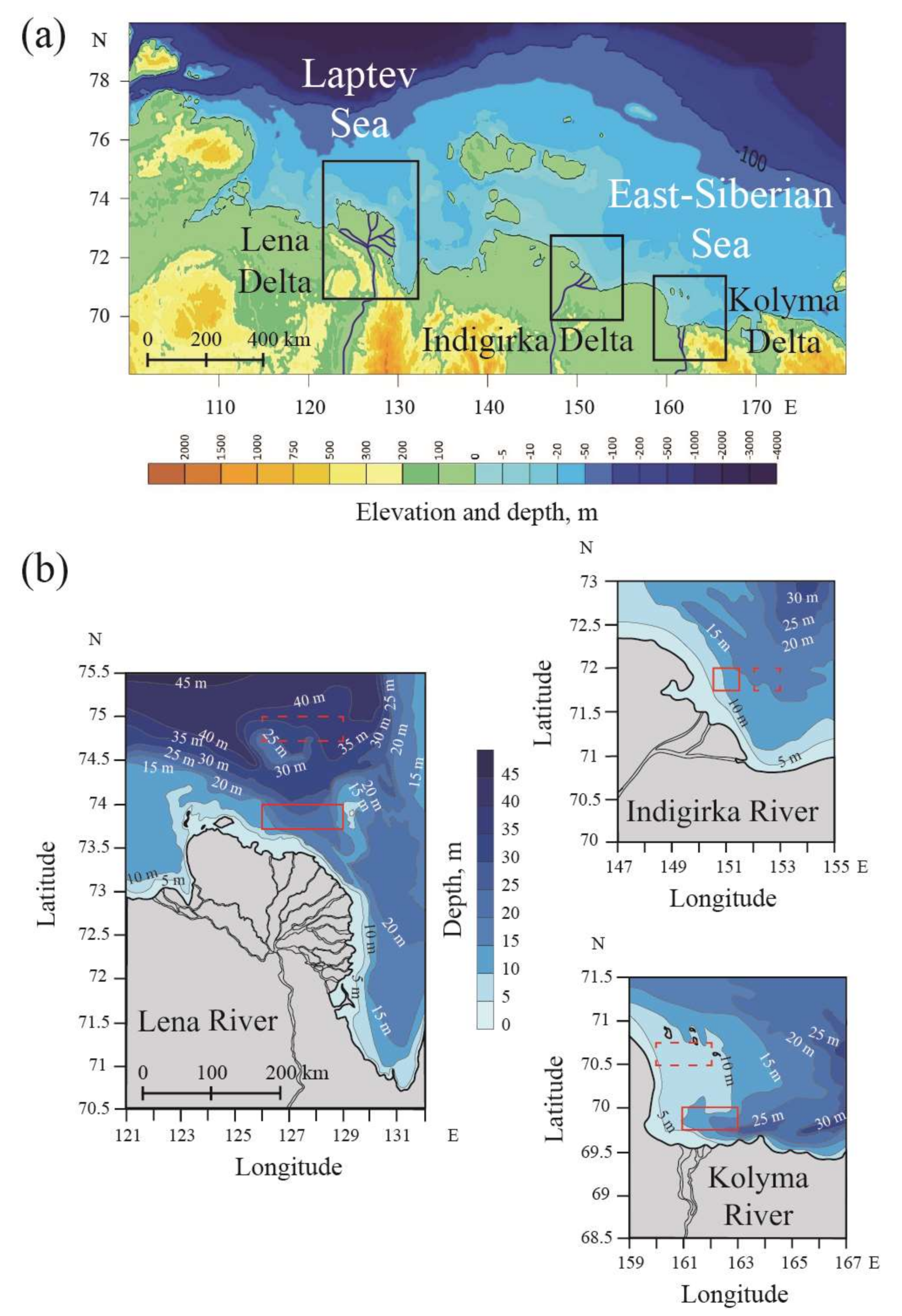

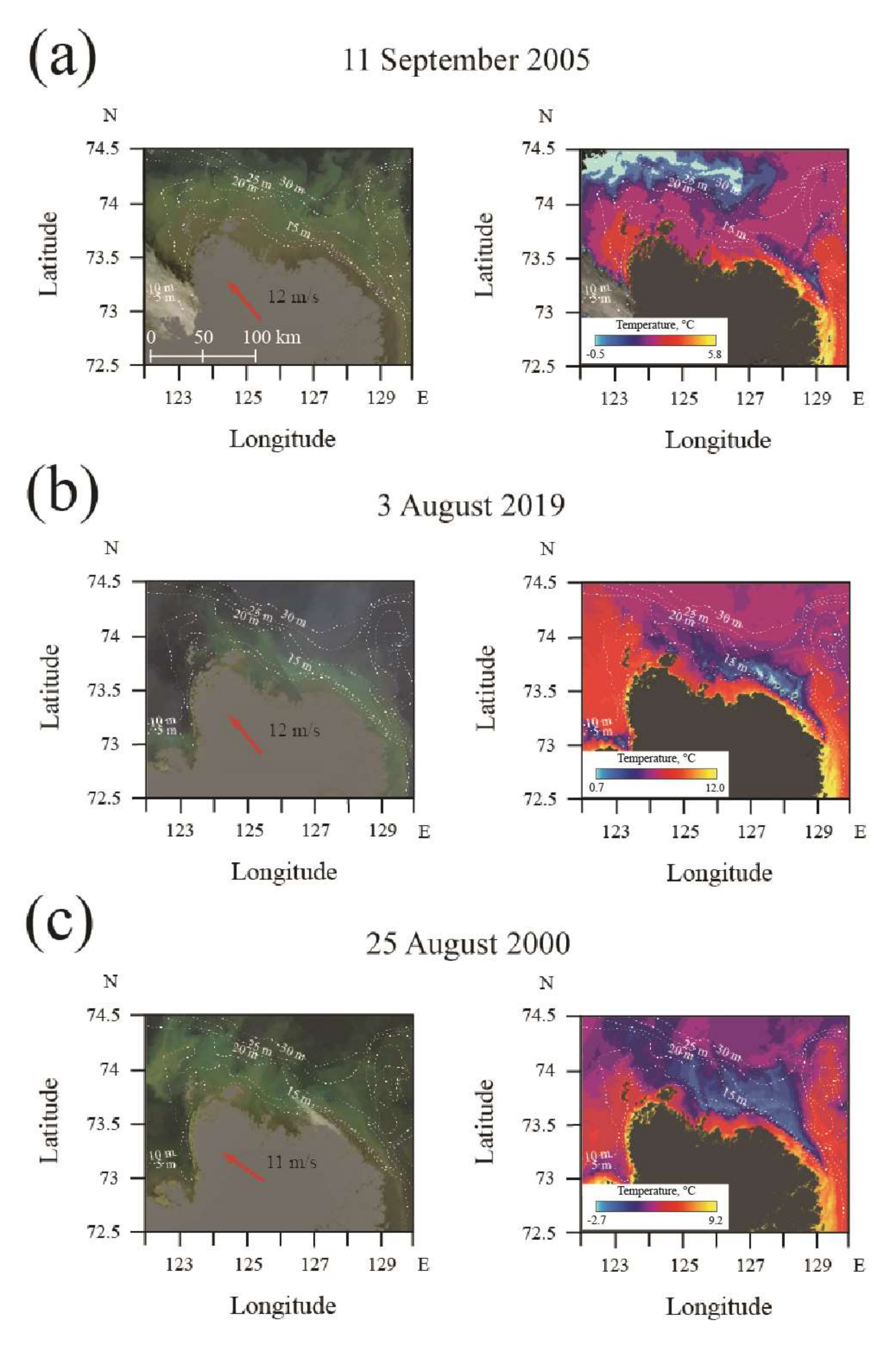
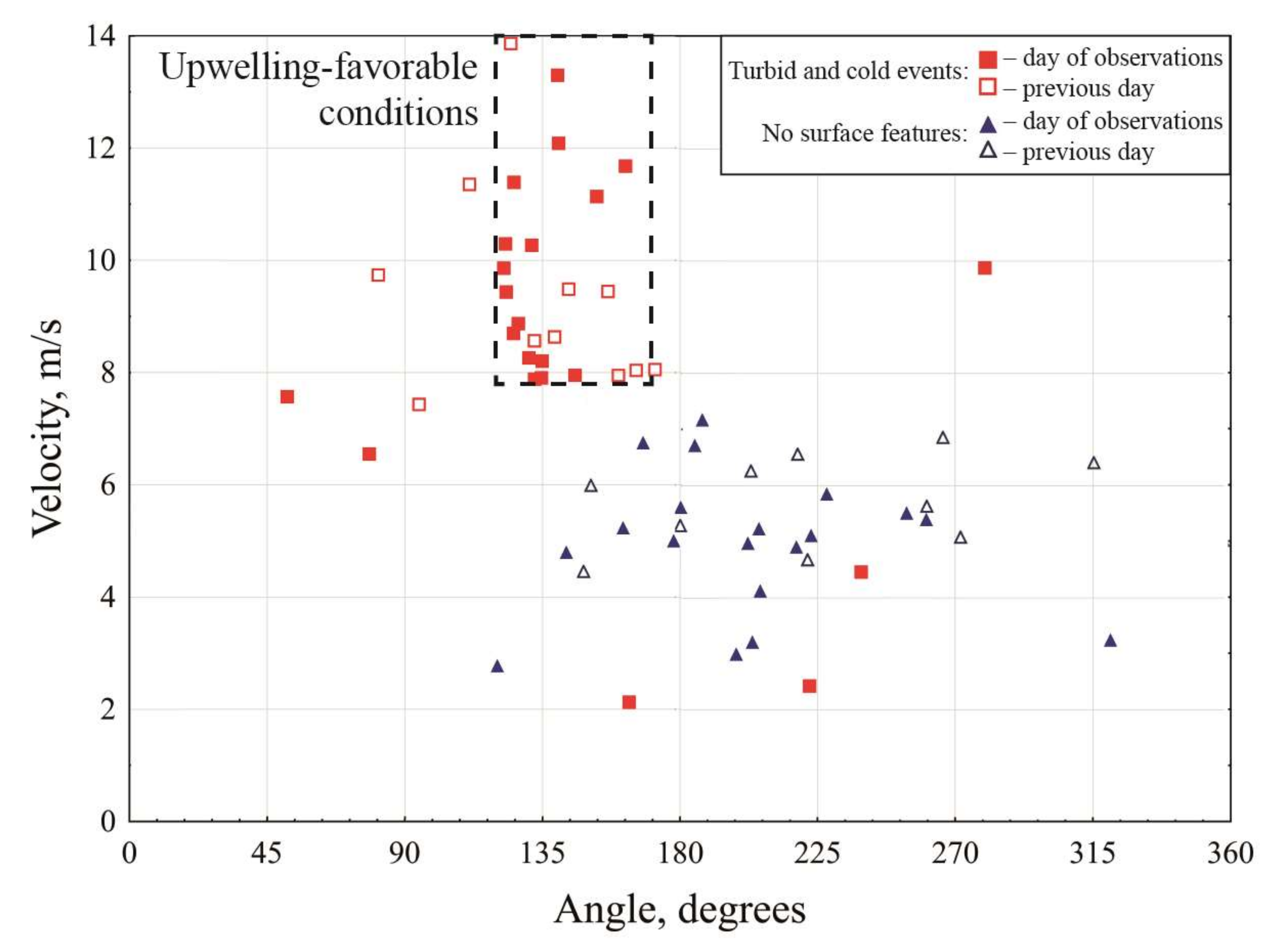
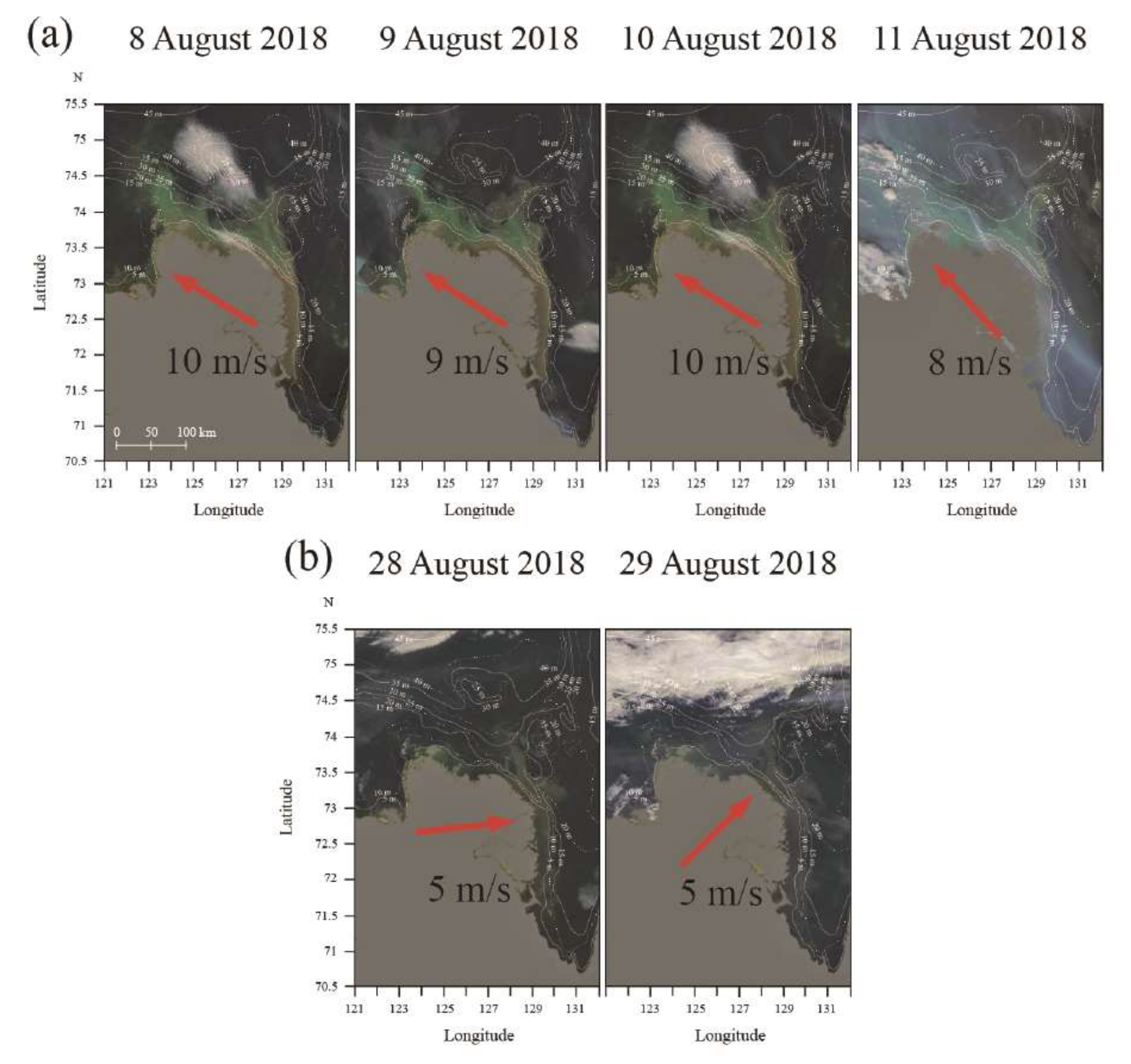
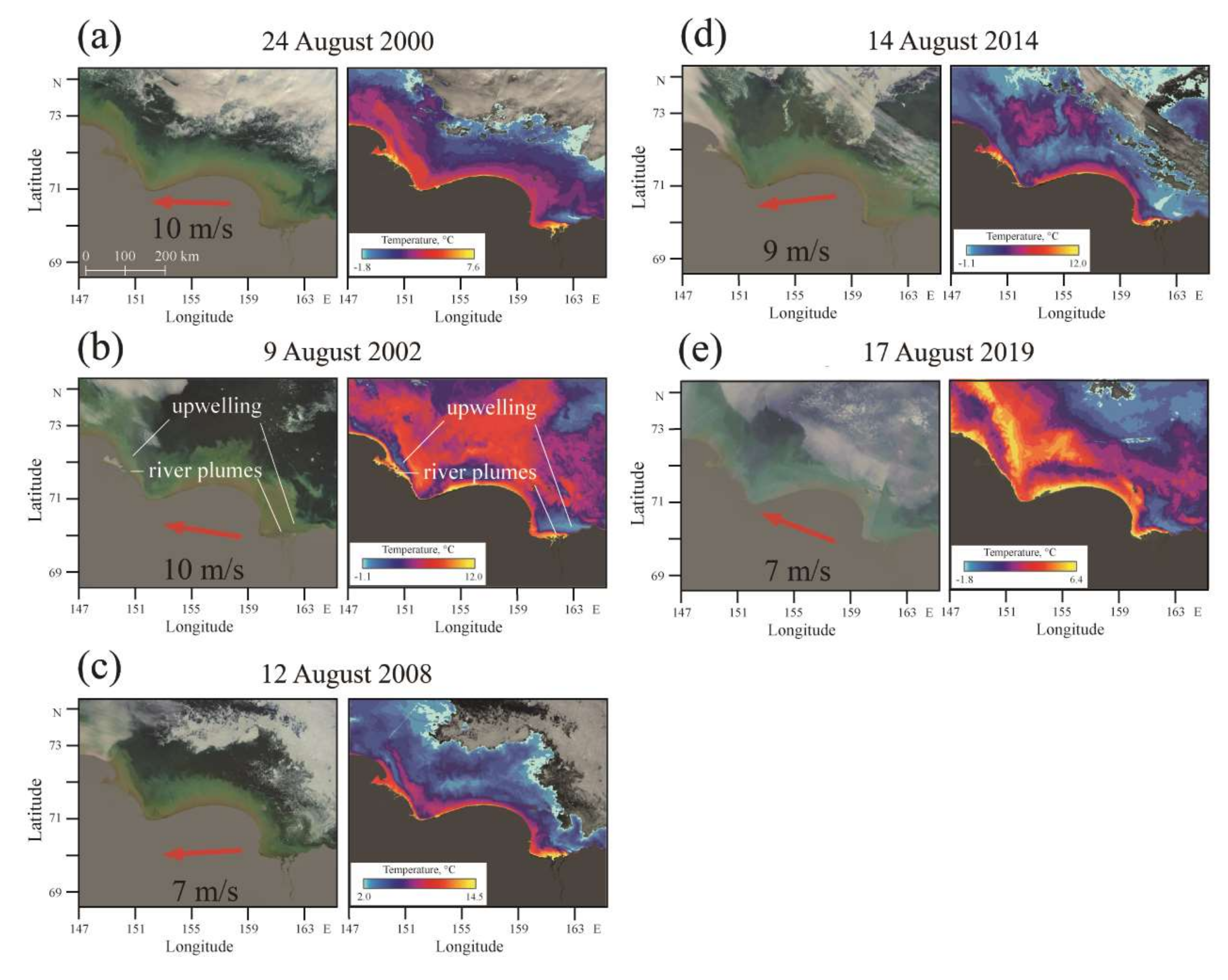
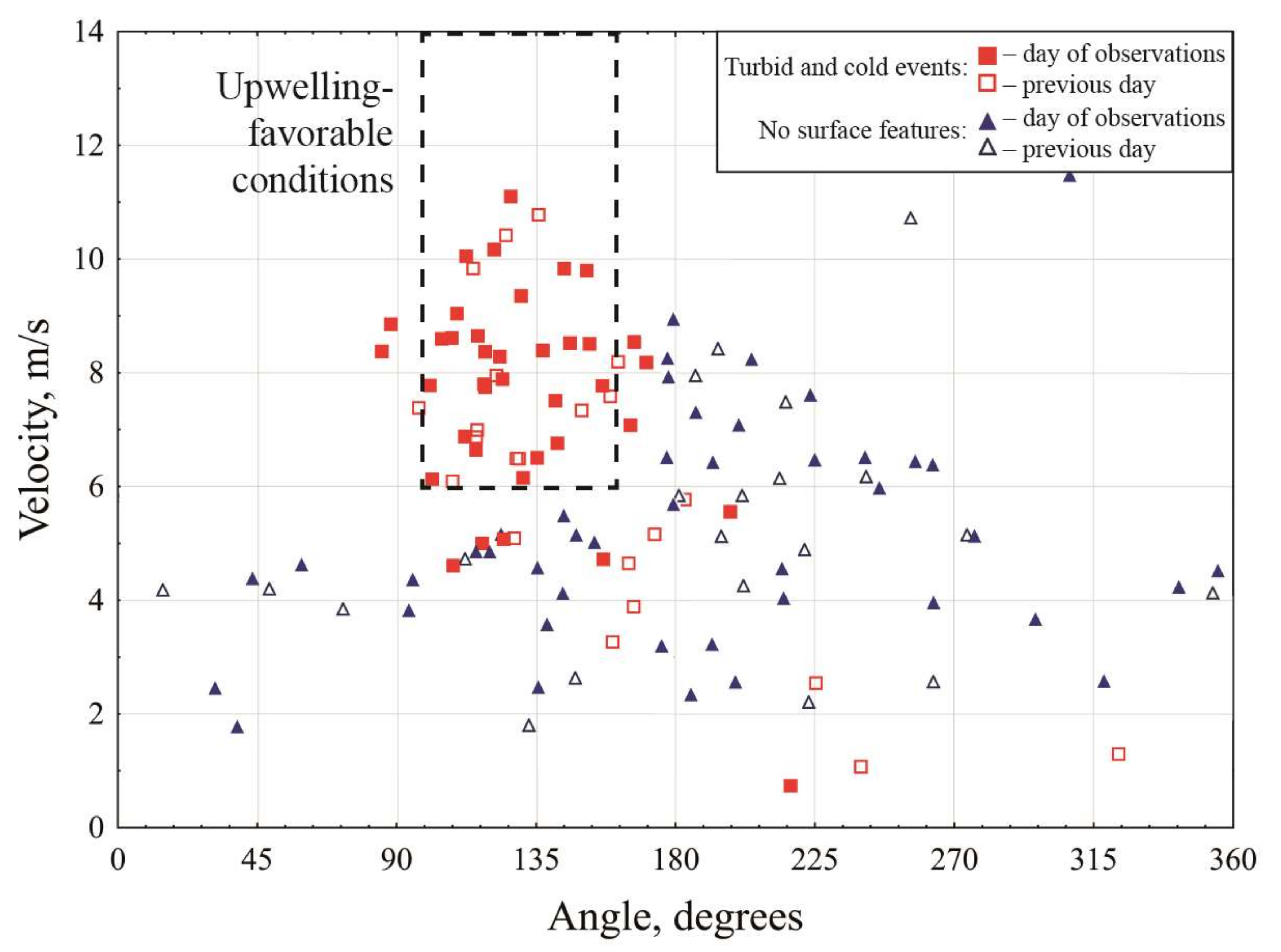

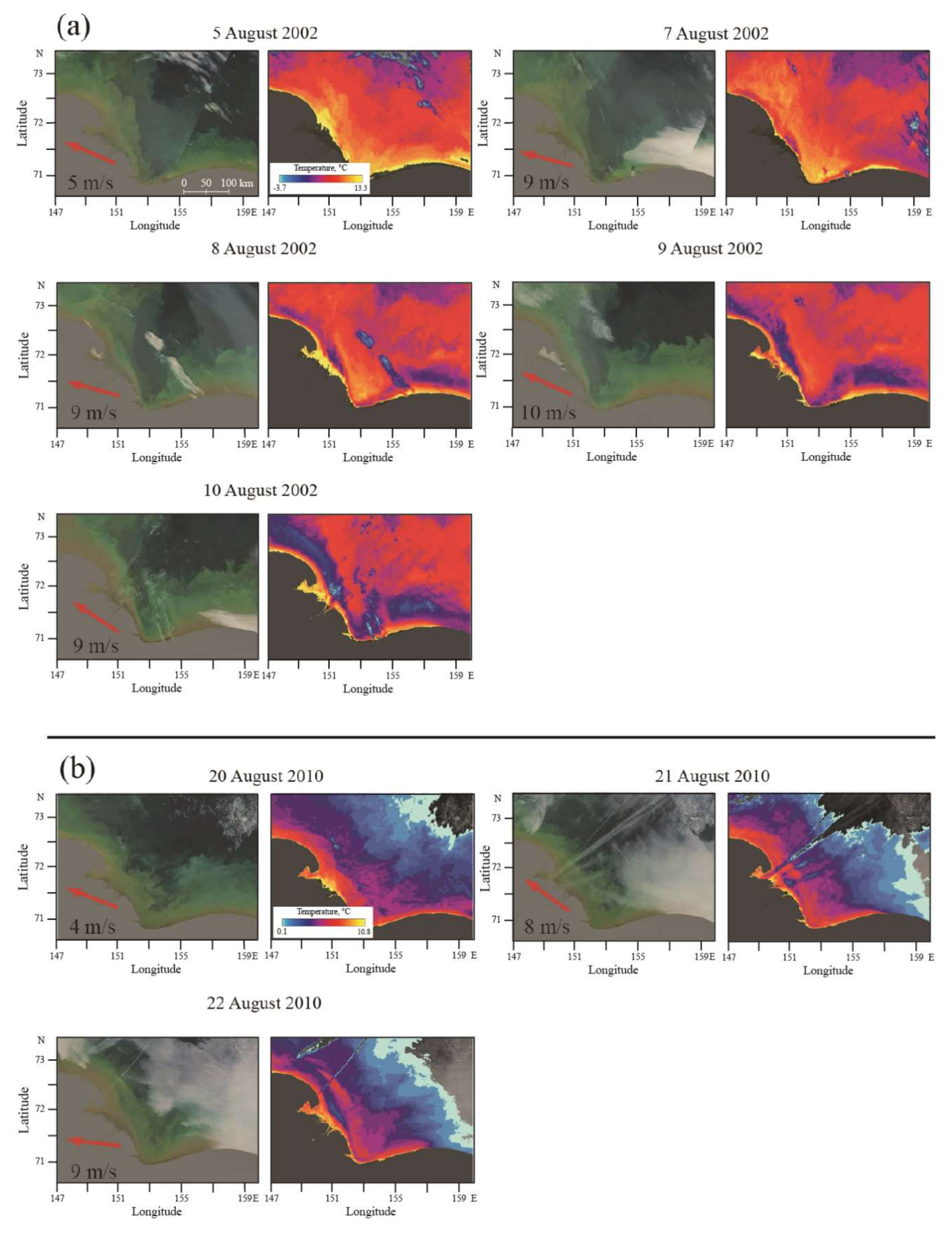
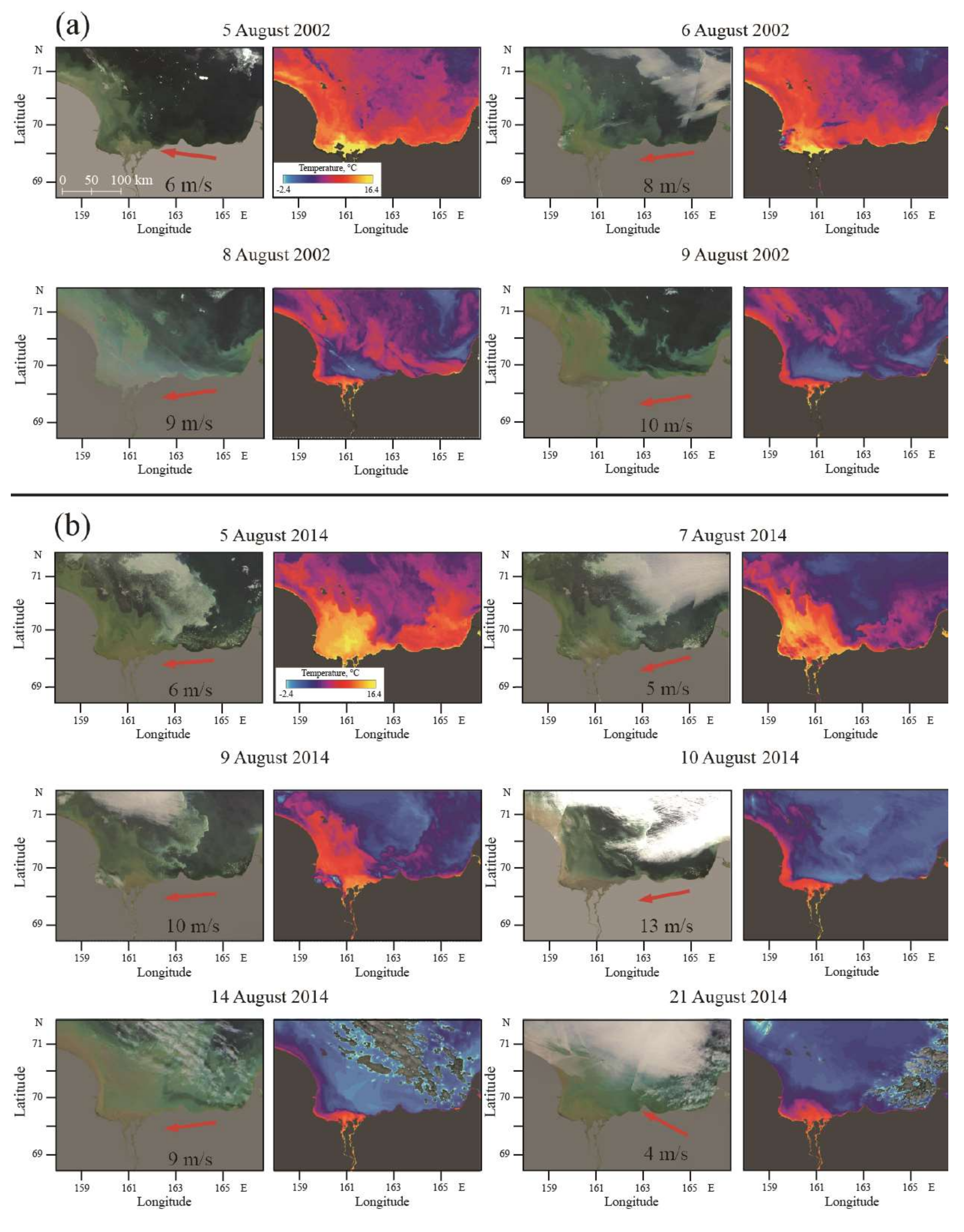

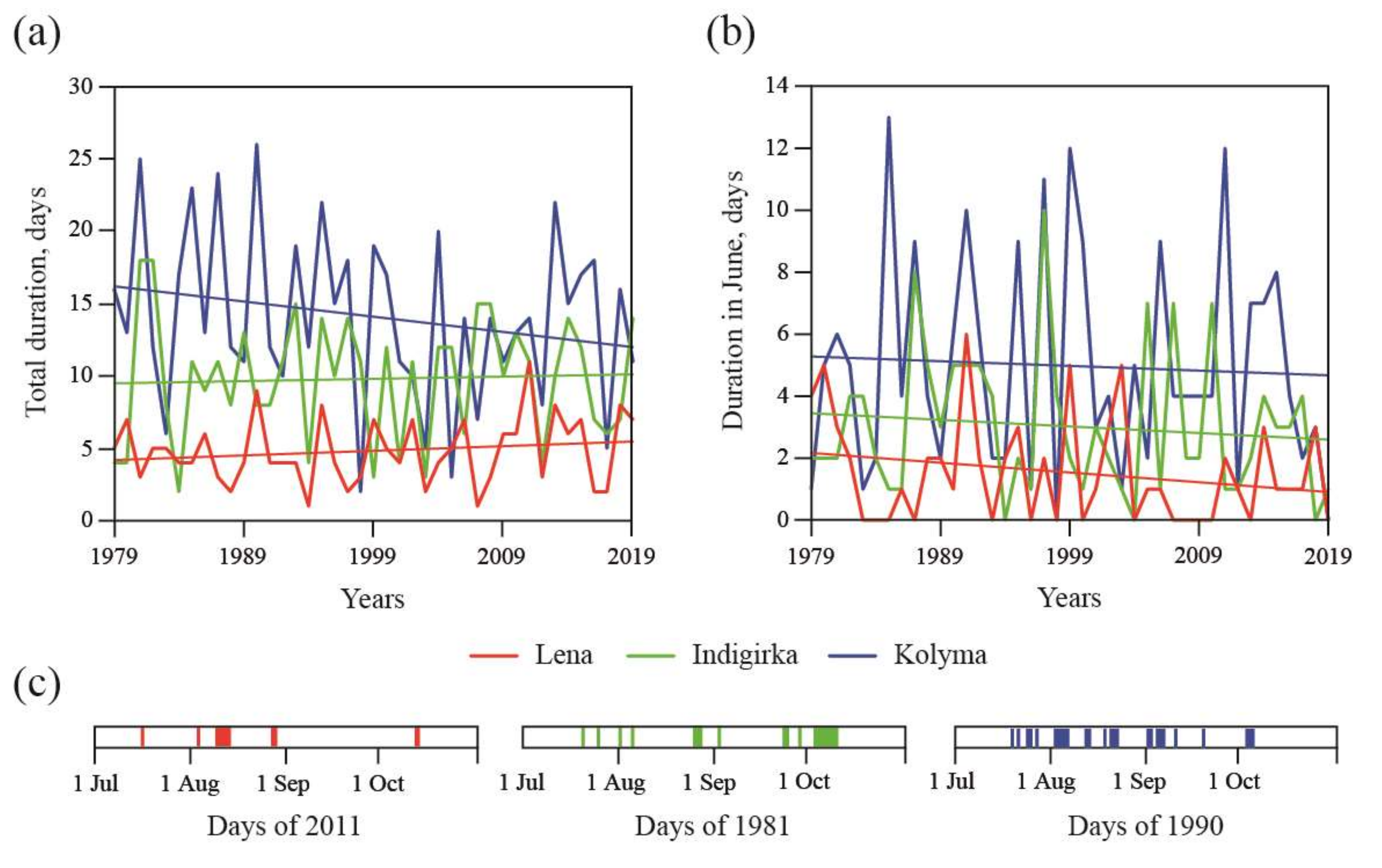
| Lena Delta | Indigirka Delta | Kolyma Delta | ||||
|---|---|---|---|---|---|---|
| Upwelling Area | Ambient Sea | Upwelling Area | Ambient Sea | Upwelling Area | Ambient Sea | |
| Longitude, °E | 126–129 | 126–129 | 150.5–151.5 | 152–153 | 161–163 | 160–162 |
| Latitude, °N | 73.75–74 | 74.75–75 | 71.75–72 | 71.75–72 | 69.75–70 | 70.5–70.75 |
© 2020 by the authors. Licensee MDPI, Basel, Switzerland. This article is an open access article distributed under the terms and conditions of the Creative Commons Attribution (CC BY) license (http://creativecommons.org/licenses/by/4.0/).
Share and Cite
Osadchiev, A.; Silvestrova, K.; Myslenkov, S. Wind-Driven Coastal Upwelling near Large River Deltas in the Laptev and East-Siberian Seas. Remote Sens. 2020, 12, 844. https://doi.org/10.3390/rs12050844
Osadchiev A, Silvestrova K, Myslenkov S. Wind-Driven Coastal Upwelling near Large River Deltas in the Laptev and East-Siberian Seas. Remote Sensing. 2020; 12(5):844. https://doi.org/10.3390/rs12050844
Chicago/Turabian StyleOsadchiev, Alexander, Ksenia Silvestrova, and Stanislav Myslenkov. 2020. "Wind-Driven Coastal Upwelling near Large River Deltas in the Laptev and East-Siberian Seas" Remote Sensing 12, no. 5: 844. https://doi.org/10.3390/rs12050844
APA StyleOsadchiev, A., Silvestrova, K., & Myslenkov, S. (2020). Wind-Driven Coastal Upwelling near Large River Deltas in the Laptev and East-Siberian Seas. Remote Sensing, 12(5), 844. https://doi.org/10.3390/rs12050844






